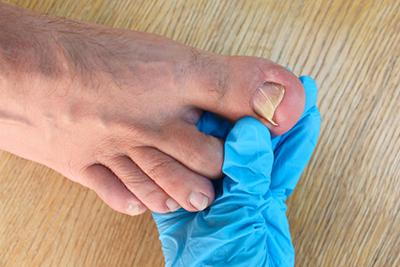
The common foot ailment known as an ingrown toenail refers to a situation when the edge of a toenail penetrates the surrounding skin, which can create pain and other uncomfortable symptoms. According to podiatrists Dr. Sara Bouraee, Dr. Jon Houseworth, Dr. Sun Byun, Dr. Daria Piotrowksi, and Dr. Shruti Vyas of Hampton Roads Foot and Ankle Specialists in Hampton and Williamsburg, VA, an ingrown toenail will most likely impact your big toe; however, the condition can happen to any toe or multiple toes on either foot.
The Symptoms of Ingrown Toenails
The most common symptoms of an ingrown toenail - a.k.a. onychocryptosis include –
- Pain/Discomfort.
- Redness/Swelling.
- The surrounding skin is sensitive to the touch. And, when most severe, it may harden and become overgrown.
- The ingrown toenail may develop into an infection, causing more intense symptoms and likely pus/discharge.
The Causes of Ingrown Toenails
An ingrown toenail can occur due to –
- Poor Nail Trimming Habits – toenails should be trimmed straight across – keeping the nail corners rounded.
- Genetic Elements - some individuals are prone to the condition based on a genetic predisposition.
- Anatomical Factors – a nail or foot may be shaped in a way that increases one's likelihood of developing an ingrown toenail.
- Poor-Fitting Shoes - wearing footwear with a tight toe box or narrow width can cause pressure that causes an ingrown toenail.
- Trauma – it is not uncommon for an ingrown toenail to happen due to an injury, like stubbing your toe.
Neglecting proper foot hygiene – that is, keeping your feet clean and dry can contribute to infections that can begin from an ingrown toenail.
Treating Ingrown Toenails
In mild cases of ingrown toenails, soaking the impact toe/foot in a warm bath of Epsom salts bath can be soothing and quite beneficial. Remember, it is essential to keep the affected areas clean and dry.
If left untreated or mismanaged, an ingrown toenail can progress to a more serious condition, potentially causing –
- An infection
- Cellulitis (skin infection), or,
- Abscess, and more.
In the presence of an infection, a podiatric specialist might recommend a course of oral antibiotic medication or a topical antibiotic to treat the condition. In certain instances, surgical intervention may be necessary. For such cases, there are minor surgical procedures available that can provide relief.
Contact a Leading Hampton/Williamsburg, VA Podiatrist
If you have persistent issues or painful symptoms related to ingrown toenails, or if you notice signs of infection (i.e., pus, increased warmth/redness), contact one of our podiatrists Dr. Sara Bouraee, Dr. Jon Houseworth, Dr. Sun Byun, Dr. Daria Piotrowksi, and Dr. Shruti Vyas or a member of the Hampton Roads Foot and Ankle Specialist's staff at (757) 220-3311 (Williamsburg), (757) 224-7605 (Hampton) or online. We look forward to offering you personalized guidance for your situation.
